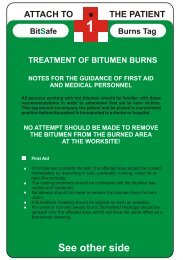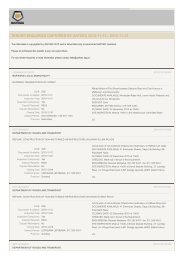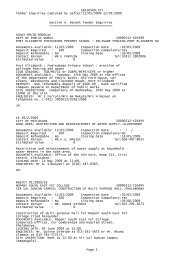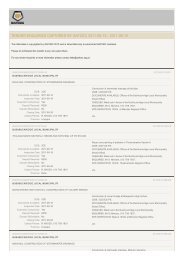DIGEST 2006 - Sabita
DIGEST 2006 - Sabita
DIGEST 2006 - Sabita
You also want an ePaper? Increase the reach of your titles
YUMPU automatically turns print PDFs into web optimized ePapers that Google loves.
But the traditionalists doggedly<br />
persist in specifying it for<br />
low-traffic roads and parking areas<br />
that:<br />
• do not lend themselves to<br />
production paving or rapid<br />
compaction;<br />
• have a fair amount of<br />
handwork;<br />
• have low quality base course<br />
(G3 to G5, laterite, crushed<br />
rubble, calcrete, all of<br />
variable quality), that is not<br />
finished to a high standard;<br />
• have actual asphalt;<br />
thicknesses that can easily<br />
range from 15 to 35mm.<br />
(Imagine the compaction<br />
window time for a 15mm<br />
thick area!).<br />
The tradition joyfully continues by<br />
making sure that most of these<br />
jobs are paved in winter, when as<br />
long as it is not raining, it's<br />
regarded as a good paving day!<br />
"The job HAS to be handed over<br />
tomorrow y'know", followed by the<br />
phrase that has supported the<br />
movies for a generation “Don't<br />
worry, everything will be OK".<br />
Ja well no fine<br />
And then the subtle assurance<br />
“I'm sure the Engineer will<br />
understand."<br />
They don't say what it is the<br />
Engineer will understand – it<br />
usually turns out to be only what<br />
the specification says! And when<br />
the core results come out, they all<br />
promptly forget about the<br />
pressure-cooker situation at the<br />
time.<br />
The result? Typical problems<br />
encountered are:<br />
• erratic and variable density,<br />
especially in winter;<br />
• excessive permeability;<br />
• erratic surface finish,<br />
particularly with handwork;<br />
• increased risk to the base<br />
from the above.<br />
The root cause of these problems?<br />
The mix design is not appropriate<br />
for the application and 25mm<br />
thickness. (It is suitable for<br />
production paving of a 40mm thick<br />
layer.)<br />
"Nonsense,” some of you will be<br />
saying, “I've been using this mix<br />
for 35 years, and can show you<br />
many roads that are still perfect."<br />
Ja well no fine!<br />
Granted, this mix is not a<br />
complete disaster, but:<br />
• specs have tightened – 95%<br />
Marshall has largely been<br />
replaced with 92% Rice;<br />
• 60/70 pen bitumen has<br />
replaced the 80/100 used 35<br />
years ago;<br />
• in my experience testing has<br />
become “more thorough” to<br />
put it politely.<br />
Certainly not every core will be a<br />
failure, but the more thoroughly<br />
you test this mix, the more<br />
failures you generally find. I too<br />
can name many roads and parking<br />
areas that have failed to some<br />
extent – failed in density and<br />
failed to last a reasonable lifespan.<br />
Am I a lone wolf howling in the<br />
wilderness?<br />
120
















